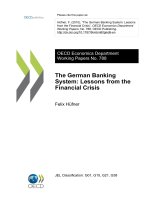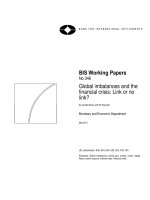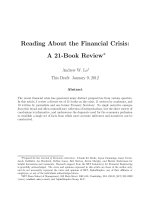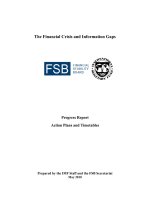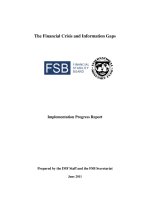dewatripont - balancing the banks; global lessons from the financial crisis (2010)
Bạn đang xem bản rút gọn của tài liệu. Xem và tải ngay bản đầy đủ của tài liệu tại đây (799.8 KB, 149 trang )
BALANCING
THE BANKS
This page intentionally left blank
BALANCING
THE BANKS
Global Lessons from the Financial Crisis
MATHIAS DEWATRIPONT, JEAN-CHARLES ROCHET,
AND JEAN TIROLE
Translated by Keith Tribe
Princeton University Press
Princeton and Oxford
Copyright © 2010 by Princeton University Press
Published by Princeton University Press,
41 William Street, Princeton, New Jersey 08540
In the United Kingdom: Princeton University Press,
6 Oxford Street, Woodstock, Oxfordshire OX20 1TW
press.princeton.edu
All Rights Reserved
Library of Congress Cataloging-in-Publication Data
Dewatripont, M. (Mathias)
Balancing the banks : global lessons from the fi nancial crisis / Mathias
Dewatripont, Jean-Charles Rochet, and Jean Tirole ; translated by Keith Tribe.
p. cm.
Includes bibliographical references and index.
ISBN 978-0-691-14523-5 (hbk. : alk. paper) 1. Banks and banking—
Government policy. 2. Banks and banking—State supervision. 3. Global
Financial Crisis, 2008–2009. 4. Financial crises—History—21st century.
I. Rochet, Jean-Charles. II. Tirole, Jean. III. Tribe, Keith. IV. Title.
HG1573.D49 2010
332.1—dc22 2009052389
British Library Cataloging-in-Publication Data is available
This book has been composed in Sabon
Printed on acid-free paper. ∞
Printed in the United States of America
10 9 8 7 6 5 4 3 2 1
Contents
Acknowledgments vii
chapter 1
Introduction—Mathias Dewatripont,
Jean-Charles Rochet, and Jean Tirole 1
Regulation in a Historical Perspective 1
To Regulate or Not to Regulate? 3
The Challenges Facing Prudential Regulation 6
Building an Adaptive Regulatory System in a Global World 7
Keeping a Balance 8
chapter 2
Lessons from the Crisis—Jean Tirole 10
Part I: What Happened? 11
Part II: How Should the Financial System Be Reformed? 47
chapter 3
The Future of Banking Regulation—
Jean-Charles Rochet 78
The Basel Accords 78
The Breakdown of the Basel Prudential Regime 86
The Necessary Reforms 100
chapter 4
The Treatment of Distressed Banks—
Mathias Dewatripont and Jean-Charles Rochet 107
Reforming Prudential Policy for Distressed Banks 110
Macroeconomic and Systemic Considerations 118
International Cooperation 122
References 131
Index 137
This page intentionally left blank
Acknowledgments
Jean Tirole thanks Nicolas Chanut, Frédéric Cherbonnier,
Jacques Delpla, Mathias Dewatripont, Pierre-Olivier Gourinchas,
Marc Ivaldi, Jean-Pierre Landau, Sylvie Matherat, Michel Pé-
bereau, Jean-Charles Rochet, Philippe Trainar, and participants
at various conferences and seminars for very useful discussions
and comments. The author is also very grateful to Keith Tribe for
translating chapter 2 from French, and to Richard Baggaley for
very helpful suggestions.
Jean-Charles Rochet thanks Charles Calomiris, Patrick Hono-
han, Rafael Repullo, and all those who attended several seminars
at the Banque de France, the Bank of Canada, and the Central
Bank of Brazil, especially Sylvie Matherat and Eduardo Lund-
berg. He has also profi ted from detailed comments made by Jean
Tirole on a draft version of his chapter. Responsibility for the
arguments advanced here lie solely with the author, of course.
Mathias Dewatripont and Jean-Charles Rochet thank Janet
Mitchell and Peter Praet.
Chapter 2 by Jean Tirole was fi rst published as “Leçons d’une
crise,” Toulouse School of Economics Notes no. 1 12/2008 (on-
line at www.tse-fr.eu/images/TSE/TSENotes/notes%281%29j
.tirole%28pdf%29.pdf).
Chapter 3 by Jean-Charles Rochet was fi rst published as “Le
futur de la réglementation bancaire,” Toulouse School of Eco-
nomics Notes no. 2 12/2008 (online at www.tse-fr.eu/images/
TSE/TSENotes/notes%282%29rochet%28pdf%29.pdf).
Chapter 4 by Mathias Dewatripont and Jean-Charles Rochet,
“The Treatment of Distressed Banks,” fi rst appeared as a chap-
ter of an electronic book by CEPR and Vox, entitled Financial
Regulation and Macroeconomic Stability: Key Issues for the G20
(edited by Mathias Dewatripont, Xavier Freixas, and Richard
Portes; see It was
prepared for a meeting held in London on January 31, 2009.
This page intentionally left blank
BALANCING
THE BANKS
This page intentionally left blank
CHAPTER 1
Introduction
Mathias Dewatripont, Jean-Charles Rochet,
and Jean Tirole
The recent fi nancial crisis was a mix of “unique” and much
more conventional events. This short book offers our perspective
on what happened and especially on the lessons to be learned in
order to avoid a repetition of this large-scale meltdown of fi nan-
cial markets, industrial recession, and public defi cits. Chapter 2
provides a diagnosis of what went wrong and discusses some key
fi nancial regulation reforms. Chapter 3 takes a more detailed look
at the fl aws in the prudential framework that was in place when
the crisis erupted and at the required remedies, and chapter 4 fo-
cuses on the treatment of distressed banks, a key element of this
prudential framework. This introduction takes a more general
look at the rationale for and challenges of banking regulation.
Regulation in a Historical Perspective
What degree of regulation of the banking sector is appropriate
has been a controversial question for almost a century. The Great
Depression, with its wave of bank failures triggered by bank runs,
led in the 1930s to heavy-handed regulation, combining deposit
insurance, interest-rate regulations, barriers to entry, restrictions
on activities (compulsory specialization), and constraints on bank
size. Although the succeeding decades witnessed a return to sta-
bility, the banking system gradually became perceived as ineffi -
cient and poorly innovative. In order to encourage cost-cutting
and innovation, and to induce banks to pass effi ciency gains on
to consumers, governments deregulated the banking industry and
fostered competition from the 1970s on. This trend was also the
result of pressure from commercial banks, which were facing
2 • Chapter 1
competition from other less regulated fi nancial institutions (e.g.,
money-market mutual funds and investment banks).
Although details vary from country to country, the removal of
interest-rate controls promoted competition at fi rst. In the tur-
bulent macroeconomic environment of the 1970s and 1980s,
though, this form of deregulation, together with an interest-rate
maturity mismatch in a period of rising interest rates, resulted in
the 1980s in a large-scale banking crisis in the United States (the
savings and loan—S&L—crisis). This crisis led to a mix of further
deregulation and reregulation. On the one hand, diversifi cation
of activities was allowed in order to reduce the specialization-
induced fragility of the S&Ls. S&Ls had used short-term sav-
ings deposits to fund long-term, fi xed-rate mortgages, and were
thereby exposed to yield-curve risk. On the other hand, in order
to limit the exposure of deposit insurance funds, the regulation
of solvency ratios became more stringent and intervention rules
in case of violation of these ratios were strengthened.
This emphasis on prudential regulation and the desire to har-
monize country-specifi c capital adequacy requirements led to the
international standard embodied in the Basel system of regula-
tion. New international regulations, including the 1988 accords,
were intended to ensure a level playing fi eld in a world of in-
creasing globalization of banking. Subsequent events made this
attempt to establish a level playing fi eld, however imperfect in
practice, seem prescient since large international banks have now
become common in the United States, Europe, and Asia.
This internationalization and the intensifi cation of competi-
tion among various marketplaces (e.g., between Wall Street and
the City of London) led to a weakening of regulatory standards,
fed by pressure from large banks, themselves facing competition
from more lightly regulated fi nancial institutions. One can inter-
pret the recent modifi cation of the Basel capital adequacy rules
(Basel II), which allow large banks to reduce effective capital ra-
tios if they can show that their risks are “limited,” as an outcome
of lobbying by these banks. The assessment of risk under the
new regulations comes from the banks themselves, through “in-
ternal models”—which represents a step toward self-regulation.
The complexity of these internal models can make it very hard
for supervisors to verify what is being computed and raises con-
Introduction • 3
cern, despite the requirement that those models be authorized by
regulatory authorities.
The trend toward weaker regulation also came from the in-
ability of the system to cope with the pace of fi nancial innova-
tion, itself fed by a desire to lower the amount of capital required
by the regulatory agencies. Indeed, the growth of the shadow
banking system, of securitization, and of structured products
(backed by credit ratings that had been infl ated by the rating
agencies) can be partly traced to this desire.
The gradual lowering of regulatory standards predated the
r ecent crisis. To be sure, other developments such as “irrational
exuberance,” loose monetary policy, and global macroeconomic
imbalances also contributed to the crisis. But underregulation or
ineffective regulation is rightly blamed for playing a central role
in the crisis. Not surprisingly, this has led to calls for a strength-
ening of regulations in a number of countries. It is worth paus-
ing, however, to ask what the purpose and extent of regulation
should be.
To Regulate or Not to Regulate?
Banking is one of a handful of industries (others include insur-
ance, fi nancial market making, and pension-fund investing) sub-
ject to prudential regulation on top of consumer protection. The
focus of this book will be on the former, and more substantial
and decisive, form of regulation. This is not to imply that insuffi -
cient consumer protection played no role in the recent crisis. In-
deed, the crisis started with problems in subprime loans. Although
these problems were small compared to the overall crisis that en-
sued, subprime lending was the release mechanism. Subprime
loans are associated with weak consumer protection regulation
of banking products in the United States. Therefore the creation
of an agency specifi cally dedicated to strengthening borrower
protection in the United States is a welcome development.
What is so unique about banks as to warrant industry-specifi c
regulation? Banks fulfi ll a specifi c role in the economy through
their involvement in the payment/deposit system as well as in lend-
ing to households and fi rms (for a survey of models of banking,
4 • Chapter 1
see Freixas and Rochet 2008). Although these activities are essen-
tial to the economy, they are no more essential than, say, cars or
pharmaceuticals, sectors in which consumer protection regulation
exists but not prudential regulation.
In banking, by contrast, prudential regulation has been in place
since the 1930s. One classical rationale for such regulation is the
vulnerability of individual banks to depositor runs. When whole-
sale and uninsured retail depositors lose confi dence in a bank,
their natural reaction is to withdraw their money from the bank
as fast as possible. Such bank runs stem from the banks’ trans-
formation activity. Banks create liquidity by borrowing short and
lending long. By allowing depositors to withdraw their money
whenever they feel like it, banks are exposed to self-fulfi lling ra-
tional panics: as shown by Diamond and Dybvig (1983), when
one expects other depositors to run and thereby force the bank
into costly asset liquidation, one’s dominant strategy becomes to
run too. The regulator’s monitoring of the institution’s leverage
(and now liquidity) positions is meant to reduce the frequency of
such costly runs.
The recent crisis (as well as some previous episodes, such as the
failure of the Long-Term Capital Management hedge fund) has
shown that another, related rationale for subjecting the banking
industry to prudential regulation could be that the failure of one
bank can trigger the failure of other banks through interbank ex-
posures or banking panics. Prudential regulation of banks—in
the form of capital ratio requirements plus deposit insurance—is
therefore warranted, especially for institutions that are large and
interconnected and thus can generate domino effects. In contrast
with nonfi nancial fi rms, which are bound to benefi t when a com-
petitor goes under, banks can be hurt both as creditors of the
failed bank and also as victims of panics that follow a neighbor’s
insolvency. Prudential regulation is therefore meant to protect
the banking infrastructure, the fi nancial system that allows the
economy to function smoothly. This warrants that specifi c atten-
tion be paid to large banks.
Yet smaller and not necessarily interconnected banks, whose
failure has no systemic consequences, are also subject to pruden-
tial regulation. The main reason for this is that their debtholders
are small and lacking in monitoring expertise. Deposit insurance
is typically introduced in order to reduce the risk that depositors
Introduction • 5
will behave erratically, but it further reduces depositors’ incen-
tive to monitor banks.
This rationale for prudential regulation—the lack of expertise
and the wastefulness associated with monitoring of balance sheets
by retail depositors—explains why prudential regulation is also
observed for other institutions with small, dispersed debtholders
such as insurance companies and pension funds. Dewatripont
and Tirole (1994) discuss in detail the specifi cs of these institu-
tions and their differences from other fi nancial and nonfi nancial
institutions that are much more lightly regulated. They formu-
late the representation hypothesis, according to which prudential
regulation should aim at replicating the corporate governance
of nonfi nancial fi rms, that is, at acting as a representative of the
debt holders of banks, insurance companies, and pension funds.
The fi nancial industry has recently substantially increased the
magnitude of its “wholesale” liabilities, that is, liabilities held not
by small depositors but by other fi nancial institutions. Does this
mean that the case for regulation has been weakened? In fact not,
because such liabilities, which are often short term and therefore
subject to panics, create systemic problems of two sorts: (1) they
imply risks for the institution’s insured depositors (a case in point
is Northern Rock; see the discussion in chapter 3), and (2) even if
the institution does not have formally insured deposits (as in the
case of investment banks or hedge funds), its failure could create
domino effects because of its high degree of interconnectedness
with other fi nancial fi rms (as was the case, for example, with the
investment bank Lehman Brothers). Consequently, the argument
behind the representation hypothesis still holds: even if the debt-
holders of banks are neither small nor inexperienced, the fact that
their deposits are short term means that when they expect trou-
ble, running is the best strategy. The danger of a bank run for the
banking system as a whole then typically prompts the authorities
to support endangered institutions. The expectation of this “too
big to fail” or “too interconnected to fail” syndrome does pre-
vent panics but it also makes the bank’s debtholders passive and
creates the potential for excessive risk-taking, in turn implying
the need for a debtholder representative to ensure discipline. The
social cost of the Lehman Brothers bankruptcy has, if anything,
reinforced this argument, since one can now safely expect big
banking institutions to be rescued in case of fi nancial distress.
6 • Chapter 1
The Challenges Facing Prudential Regulation
According to the representation hypothesis, regulation should
mimic the role played by creditors in nonfi nancial fi rms. Since
debt gives its owners the right to take control of their borrowers’
assets in bad times, regulators must take control of banks in bad
times in order to limit the losses of depositors or of the deposit
insurance fund. This, in turn, implies the necessity of (1) defi ning
what “bad times” means, and (2) making sure that one can in-
tervene in those circumstances. This is no easy task, even when
trouble hits only a single institution; we discuss this case fi rst,
and then turn to the more complicated case of multi-institution
hardship prompted by negative macroeconomic shocks.
For a single institution, bad times are defi ned as times at which
its capital falls below the regulatory solvency ratio, as defi ned by
the Basel I and II international agreements. Such defi nitions, al-
though increasingly complex over time, nonetheless yield only
rough approximations of a bank’s riskiness; for example, they
concentrate only on credit risk, and do not fully take into ac-
count portfolio risk. Moreover, even in “normal” times, it is a
challenging task for the regulator to intervene early enough, given
that there is always an “accounting lag” in the computation of
solvency. Moreover, this challenge is exacerbated by the fact
that, in contrast to nonfi nancial fi rms, banks can take advantage
of (explicit or implicit) deposit insurance and “hide” problems of
insolvency by aggressively raising money through higher interest
rates, a strategy that has been called “gambling for resurrection.”
“Market discipline” can to some extent be relied on to help
provide early warning signals of a bank’s trouble. This can work,
however, only if some of the bank’s debt is not explicitly or im-
plicitly insured by the state (otherwise its risk premium is zero)
or if it is privately insured, so that its insurance premium would
refl ect market perceptions of its riskiness. Such market discipline
can in fact precipitate a crisis by making it more expensive for a
bank in trouble to remain insured, and it does not make public
intervention in bad times less essential; put differently, market
discipline can be only a complement to, not a substitute for, pub-
lic intervention.
Prompt intervention in an individual insolvency is not straight-
Introduction • 7
forward, but it is even harder in the case of generalized insol-
vency resulting from a macroeconomic shock. Indeed, multiple
factors make taking control of banks during a banking crisis
much more complicated. First, banks can expect some sympathy
from politicians when they argue that the responsibility is not
theirs but instead that of poor macroeconomic conditions. Sec-
ond, politicians may quickly be faced with a drained deposit
insurance fund and be very reluctant to request money from tax-
payers to cover the cost of intervention. Third, competent staff
from regulatory authorities are likely to be overwhelmed by the
sudden magnitude of the task of overseeing multiple intercon-
nected distressed fi nancial fi rms at once.
In such cases, the temptation to manage the accounts of banks
so as to pretend that they are not really insolvent is strong. Such
forbearance has been practiced in various crises (e.g., the S&L
crisis of the 1980s) but it is dangerous: insolvent banks do mis-
behave (gambling for resurrection was rampant among S&Ls, for
example) and experience shows that the cost to the taxpayer,
though delayed, is magnifi ed in the end by such cover-ups. His-
tory tells us that, when a crisis hits, honest and speedy cleanups
of bank balance sheets are highly desirable: real money is re-
quired; accounting tricks won’t do. A striking example is pro-
vided by the contrast between the Scandinavian and Japanese
crises of the 1990s: Japan’s procrastination led to years of slug-
gish GDP growth while Scandinavia “bit the bullet” and came
back to satisfactory growth much more quickly.
Building an Adaptive Regulatory System
in a Global World
One problem with regulation in recent years is that it has faced
accelerating fi nancial innovation. Of course, fi nancial innovation
is driven not just by the desire to serve customers better: it can be
the result of pure regulatory arbitrage rather than an attempt to
increase social surplus (think of structured products with origi-
nators keeping senior tranches in order to minimize capital re-
quirements and providing huge off-balance-sheet, and therefore
low-capital-requirement, liquidity support to the conduits). More
8 • Chapter 1
generally, one can expect regulatory arbitrage by the industry (as
in the case of rating agencies offering consulting services to boost
the ratings of hard-to-understand structured products).
As a consequence, when drafting regulation, legislators should
explicitly start from the assumption that these factors will be at
play, and they should be willing to adapt the system without
delay to these developments. This has, unfortunately, not been
the case: regulation is too often designed to “fi ght the previous
crisis” rather than the next one, and is typically one step behind
market developments. The trend toward global banking has ex-
acerbated regulation’s lag behind market developments.
Indeed, as stressed earlier, recent years have witnessed two
signifi cant trends: bigger fi nancial institutions on the domestic
scene (with many domestic mergers) and accelerating globaliza-
tion (partly due to cross-border mergers). On the one hand, these
trends have signifi cantly increased the domestic lobbying power
of fi nancial institutions, thereby giving more prominence to a
laissez-faire approach. On the other hand, globalization in a
world of hard-to-coordinate international regulatory policies has
increased the lag between private-sector developments and regu-
latory responses. Taken together, these factors led to Basel II
regulatory rules that were less demanding than their predeces-
sors in terms of capital and that even started delegating bits of
the actual implementation of supervision to private-sector actors,
namely rating agencies or even the (big) banks themselves.
Keeping a Balance
The previous trend toward decreasing capital requirements and
increasing delegation of oversight to banks and credit-rating agen-
cies clearly requires a correction, namely a strengthening of reg-
ulation. In the recent crisis, the pendulum can be expected to
swing in this direction. In such complex industries, however, there
are many challenges on the road to effi cient regulation.
The fi rst challenge is the need to avoid overreaction: regulation
should mimic for banks the corporate governance of nonfi nancial
fi rms, not “punish” banks just in order to place blame for the
crisis. Although fi nancial institutions that are not yet regulated
Introduction • 9
should be regulated if the regulated sector has large exposures to
them (for example, if they are systemically important owing to
their large volume of over-the-counter trades with the regulated
sector), and although capital ratios should be raised in com-
parison to precrisis levels, it is much less clear that one should,
for example, become prescriptive in terms of business models in
banking: the crisis has hit some small as well as some large banks,
some private as well as some state-owned banks, and some spe-
cialized as well as some universal banks.
The second challenge is the need for politicians to avoid the
temptation to be especially harsh in their treatment of banks that
have received a bailout—for example, by limiting their ability to
pay managers in comparison to their competitors. This can be
counterproductive because it means putting them at a competi-
tive disadvantage toward those banks that have not been bailed
out, at least directly (but that may nonetheless have been indirect
benefi ciaries of bailouts, as creditors of bailed-out banks). By
contrast, it does make sense to promote compensation schemes
that incentivize bank managers to take a long-term perspective.
Finally, a danger of the recent crisis is that cross-border bank-
ing might collapse. This problem, which would be less dire for
some large countries such as the United States, is of fi rst-order
importance for European countries and some emerging markets.
It is linked to the fact that bailout money originates from na-
tional treasuries—which are responsible to national electorates—
and not from an internationally coordinated insurance fund.
Therefore, it is not a surprise that bailed-out banks have in many
cases been ordered to favor domestic lending. This trend can
mean the end of the European Union’s Single Market in banking,
which is bad news for the Single Market in general, and there-
fore for economic growth and effi ciency.
The challenges, thus, are numerous. The three essays in this
volume discuss a number of principles to deal with these chal-
lenges, addressing the microeconomic incentives of fi nancial in-
stitutions, the impact of macroeconomic shocks, and the role of
political constraints.
CHAPTER 2
Lessons from the Crisis
Jean Tirole
This chapter aims to contribute to the debate on fi nancial sys-
tem reform. In the fi rst part I describe what I perceive to be a
massive regulatory failure, a breakdown that goes all the way
from regulatory fundamentals to prudential implementation. Al-
though there has been some truly shocking behavior in the world
of fi nance, the universal denunciation of “fi nancial madness” is
pointless. Managers and employees in the fi nancial industry, like
all economic agents, react to the information and incentives with
which they are presented. Bad incentives and bad information
generate bad behavior. Accordingly, this chapter starts by listing
the principal factors that led to the crisis. Although many excel-
lent and detailed diagnoses are now available,
1
the fi rst section
1
A particularly readable one is the interesting compendium of contributions
by NYU economists edited by Acharya and Richardson (2009). More concise
and very useful treatments include the introductory chapter of that book as well
as Hellwig (2009).
Of course, this review is bound to become dated with respect to rapidly chang-
ing events, new proposals, and meetings of one sort or another. For example, this
chapter was completed before the December 2009 Basel club of regulators’ pro-
posal of a new solvency and liquidity regime that would deemphasize banks’ in-
ternal models of risk assessment, force them to hoard enough liquidity to with-
stand a 30-day freeze in credit markets and to reduce their maturity mismatch,
and prohibit those banks with capital close to the minimum required from dis-
tributing dividends. The chapter was also completed before President Obama’s
January 21, 2010, announcement of (among other things) his desire to ban retail
banks from engaging in propriety trading (running their own trading desks and
owning, investing, or sponsoring hedge funds and private equity groups). More
generally, Part I makes no attempt at providing an exhaustive account of the crisis
or of the various reform proposals that followed it.
I think it fair to say, however, that the underlying policy issues and fundamen-
tal tensions, as discussed in the second part of my chapter and in the rest of the
book, will not change so quickly. For example, a G20 meeting or two is not going
to remove the problem of maturity mismatches or solve the problem of the expo-
sure of the regulated sphere to the unregulated.
Lessons from the Crisis • 11
refl ects my own interpretation and is therefore key to understand-
ing the policy conclusions I present later.
Many policy makers have forgotten that effective regulation is
needed for healthy competition in fi nancial markets, that eco-
nomic agents should be held accountable for their actions, and
that institutions and incentives should lead to a convergence of
private and public interests. Although recent events do offer an
opportunity for a thorough overhaul of international fi nancial
regulation, it is important to strike a balance, showing appro-
priate political resolve while avoiding the danger of politically
motivated reforms in a highly technical domain. The second part
of this chapter discusses some implications of recent events for
fi nancial-sector regulation.
Part I: What Happened?
The crisis, originating in the U.S. home loans market, quickly
spread to other markets, sectors, and countries. The hasty sale of
assets at fi re-sale prices, a hitherto unprecedented aversion to risk,
and the freezing of interbank, bond, and derivatives markets re-
vealed a shortage of high-quality collateral. Starting on August 9,
2007, when the Federal Reserve (Fed) and the European Cen-
tral Bank (ECB) fi rst intervened in response to the collapse of the
inter bank market, public intervention reached un precedented
levels. Few anticipated on that day that many similar interven-
tions would follow, that authorities in various countries would
have to bail out entire sectors of the banking system, that the bail-
out of some of the very largest investment banks, a major inter-
national insurance company, and two huge government-sponsored
companies guaranteeing mortgage loans would cost the American
taxpayer hundreds of billions of dollars. A little more than a year
later, in the autumn of 2008, the American government had al-
ready committed 50 percent of U.S. GDP to its remedial efforts.
2
2
In mid-November 2008, Bloomberg estimated that $7,400 billion, an amount
equal to 50 percent of U.S. GDP, had been guaranteed, lent, or spent by the Fed,
the U.S. Treasury, and other federal agencies. On September 2, 2009, the Federal
Reserve had $2,107 billion in various assets (including mortgage-backed securi-
ties, commercial paper loans, and direct loans to AIG and banks), the Treasury
$248.8 billion in Troubled Asset Relief Program (TARP) investments in banks
12 • Chapter 2
Equally unforeseen was that American and European govern-
ments would fi nd themselves lending signifi cant sums directly to
industrial companies to save them from bankruptcy.
Although the crisis has macroeconomic consequences in terms
of an immediate and severe recession and of a sharp increase in
public debt,
3
this chapter is concerned with fi nancial regulation.
Policy makers and economists must have a clear understanding
of what happened in order to suggest ways out of the crisis, and
especially to propose reforms that will fend off future crises of a
similar nature. The proper application of standard economics
would in some areas have surely allowed us to steer clear of many
obvious errors; and yet the crisis provides us with prima facie
evidence on how regulations are designed and evaded, and scope
for new thinking about our fi nancial system.
The recent fi nancial crisis will quickly become a central case
study for university courses on information and incentives. The
losses on the American subprime mortgage market,
4
although
signifi cant, were very small relative to the world economy and by
themselves could not account for the ensuing “subprime crisis.”
In other words, the subprime market meltdown was just a deto-
nator for what followed, namely a sequence of incentives and
market failures exacerbated by bad news. At each stage in the
chain of risk transfers, asymmetric information between contract-
ing parties hampered proper market functioning.
Nonetheless, market failures related to asymmetric informa-
tion are a permanent feature of fi nancial markets, so the crisis
cannot be explained simply in terms of market failures. Two other
factors played a critical role. First, a blend of inappropriate and
poorly implemented regulation, mainly in the United States but
also in Europe, gave individual actors incentives to take sizable
and AIG, and the Federal Deposit Insurance Corporation (FDIC) $386 billion in
bank debt guarantees and loss-share agreements (source: Wall Street Journal Eu-
rope edition).
3
Budget defi cits have reached levels unprecedented in peacetime; the steep rise
in indebtedness of Western governments will limit room for maneuver in the me-
dium term. Sovereign debt crises might even emerge in member countries of the
Organization for Economic Cooperation and Development (OECD), a contin-
gency that was rather remote before the crisis.
4
Around $1,000 billion, or only 4 percent of the market capitalization of the
New York Stock Exchange at the end of 2006 ($25,000 billion), according to
the November 2008 estimates of the International Monetary Fund (IMF).
Lessons from the Crisis • 13
risks, with a major portion of these risks ultimately borne by
taxpayers and investors. Second, market and regulatory failures
would never have had such an impact if excess liquidity had not
encouraged risk-taking behavior.
A Political Resolution to Favor Real Estate
The U.S. administration, Congress, and other offi cials, including
some at the Fed, were eager to promote the acquisition of homes
by households.
5
In addition to the incentive for purchasing a
home provided by the long-standing and generous tax deduct-
ibility of interest paid on mortgages, households were encour-
aged to lever up their debt in order to acquire homes.
6
Consumer
protection was weak, to say the least. Many subprime borrowers
were given low “teaser” rates for two or three years, with rates
skyrocketing thereafter. They were told that real estate prices
would continue to increase and therefore they would be able to
refi nance their mortgages. Similarly, mortgages indexed to mar-
ket interest rates (adjustable-rate mortgages, ARMs), which raise
obvious concerns about borrowers’ ability to make larger pay-
ments when interest rates rise, were promoted in times of low
interest rates.
7
Alan Greenspan himself called for an increase in
the proportion of ARMs.
8
5
Fortunately, this was not the case in the euro area, where the ECB followed
a more stringent monetary policy and authorities in a number of countries did
not encourage subprime loans. Of course, loose monetary policy is only a con-
tributing factor, as can be seen from the examples of Australia and Great Britain,
two countries where the mortgage market boomed in spite of relatively normal
interest rates.
6
There are several very good outlines of the excesses linked to the housing
market—see, for example, Calomiris (2008), Shiller (2009), and Tett (2009).
7
France has for the most part been spared this phenomenon. French banks
have traditionally lent to solvent households, a practice reinforced by law (the
Cour de Cassation ruled against a fi nancial institution that had failed in its duty
of care by granting a loan incommensurate with the borrower’s present or future
capacity to repay). Variable-rate loans have always played a relatively minor role
in France (24 percent of outstanding loans in 2007), and completely fl exible
loans, where neither interest rates nor monthly payments are capped, have al-
ways had a very small market share (less than 10 percent). Adjustable-rate mort-
gages are, by contrast, very popular in Spain, the United Kingdom, and Greece.
8
According to USA Today (February 23, 2004), “While borrowers can refi -
nance fi xed-rate mortgages, Greenspan said homeowners were paying as much as
14 • Chapter 2
Finally, public policy encouraged institutions to lend to sub-
prime borrowers through several channels. Fannie Mae and Fred-
die Mac were pushed to increase the size of their balance sheets.
And loose regulatory treatment of securitization and mortgage-
backed securities helped make mortgage claims more liquid.
In response to these policy and social trends, subprime lending
changed in nature. Before the fi rst decade of the twenty-fi rst cen-
tury, lenders would carefully assess whether subprime borrowers
were likely to repay their loans. By contrast, recent subprime
lending involved an explosion of loans without documentation.
For instance, lenders were able to base their calculations on
claimed, rather than actual, income. We will return to these de-
velopments.
Not surprisingly, U.S. homeownership rose over the period
1997–2005 for all regions and for all age, racial, and income
groups. The fraction of owner-occupied homes increased by 11.5
percent over this period. Housing prices moved up nine years in
a row, and across the entire United States.
9
The rise was particularly spectacular for low-income groups.
Correspondingly, real estate price indexes in the lowest price tier
showed the biggest increases until 2006 and the biggest drop
afterward.
Excessive Liquidity, the Savings Glut,
and the Housing Bubble
Crises usually fi nd their origin in the lack of discipline that pre-
vails in good times. Macroeconomic factors provided a favor-
able context for fi nancial institutions to take full advantage of
the breaches created by market and regulatory failure. In addi-
tion to the political support for real estate ownership, there are
several reasons why the origin of the crisis was located in the
United States:
0.5 to 1.2 percentage points for that right and the protection against a potential
rate rise, which could increase annual after-tax payments by several thousand
dollars. He said a Fed study suggested many homeowners could have saved tens
of thousands of dollars in the last decade if they had ARMs.” Adjustable-rate
mortgages made up 28 percent of mortgages in January 2004 in the United States.
9
These data are taken from Shiller (2009, 5, 36).
